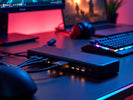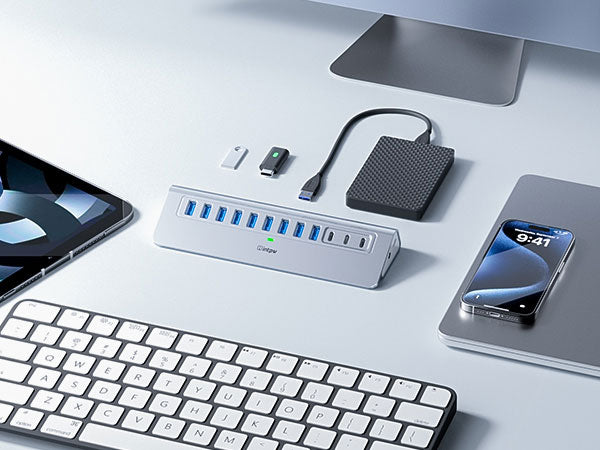
USB Hub Data Transfer Guide: Speed, Tech & Choosing the Best USB Hub
, by USintpw, 5 min reading time

, by USintpw, 5 min reading time
In our hyper-connected world, data is the lifeblood of our digital existence. From streaming movies to backing up precious memories, we rely on the seamless transfer of information between devices. The unsung hero facilitating this? Often, it's the humble USB hub. But how does this little device actually work, and how do you ensure you're getting the fastest, most reliable data transfer speeds?
This USB hub data transfer guide will demystify the technical magic behind these essential gadgets, empowering you to make informed decisions and maximize your data transfer potential with USB Hubs.

Data transfer, at its core, involves moving information from one location to another in the form of electrical signals. Think of it as sending messages along a wire, where specific voltage levels and patterns represent different bits of data. These signals are encoded and decoded to ensure accurate and efficient transmission.
The magic happens through protocols and standards that dictate how devices communicate, ensuring a shared language for seamless data exchange.
USB (Universal Serial Bus) simplifies this process by providing a standardized interface for connecting devices. It's a protocol designed for serial communication, meaning data is sent one bit at a time, rather than in parallel.
This approach simplifies cable design and reduces the number of wires required. USB employs sophisticated techniques like packet-based communication, error detection, and flow control to ensure data integrity.

When it comes to USB hubs, several key features differentiate a good one from a great one. These features play a crucial role in optimizing data transfer speeds and overall reliability.
These critical elements include port speed, build quality, power delivery, and compatibility with various devices.
The primary function of any USB hub is, of course, to expand the number of available USB ports on your computer or laptop. But a modern usb hub offers far more than just port multiplication.
They act as central connectivity hubs, streamlining your workspace and allowing you to connect a multitude of devices simultaneously, increasing productivity exponentially.
Physically, a USB hub acts as a signal repeater and splitter. It receives data from the host device (your computer), amplifies the signal, and then distributes it to the connected peripherals. It is like a highly sophisticated and optimized traffic controller.
The hub's internal circuitry includes a controller chip that manages the data flow and ensures each device receives the necessary bandwidth.

The most important difference between USB versions, especially concerning usb hub 3.0 hubs, lies in the speed. USB 2.0 offers a maximum theoretical data transfer rate of 480 Mbps (Megabits per second), while usb hub 3.2 hubs and usb 3.0 boast up to 5 Gbps (Gigabits per second).
This translates to significantly faster file transfers, smoother video streaming, and improved performance for data-intensive applications. A jump of many orders of magnitude in throughput.
Understanding USB Hub Data Transfer involves several factors. It’s not just about the speed of the port, but also the devices connected, the cables used, and the overall system configuration.
High-quality cables, efficient drivers, and a powerful host computer all contribute to optimal data transfer rates, ensuring seamless data flow.
The use cases for USB hubs are as diverse as the devices they connect. From photographers transferring large image files to musicians recording audio tracks, the applications are endless.
Gamers also benefit from USB hubs by connecting multiple peripherals such as keyboards, mice, headsets, and game controllers simultaneously. Think of using usb hub for pc as your central controller for all gaming accessories.

Maximizing USB Hub Performance requires careful consideration of several key factors. Start by choosing a hub that supports the highest USB standard your devices are compatible with.
Using high-quality cables, avoiding excessive cable lengths, and ensuring your hub has adequate power, especially when using a usb hub with power source, can significantly enhance data transfer speeds and stability.
Many users find themselves needing a usb hub with power supply, particularly when connecting multiple high-power devices. These hubs provide dedicated power, preventing performance degradation and ensuring stable operation.
Consider a powered hub if you regularly connect external hard drives, charging devices, or other power-hungry peripherals to your usb hub.

Modern USB hubs often incorporate additional ports like hdmi, vga, and type c to cater to diverse connectivity needs. This versatility allows you to connect displays, projectors, and other peripherals without the need for cumbersome adapters.
And our hubs are designed to be comprehensive connectivity solutions, simplifying your setup and streamlining your workflow.
Data transfer is a fundamental aspect of our digital lives, and a reliable USB hub is essential for ensuring seamless connectivity and optimal performance. By investing in a quality INTPW USB hub, you're investing in your productivity and peace of mind.
Unlock the full potential of your devices and experience the power of efficient data transfer with INTPW.

Subscribe to our emails